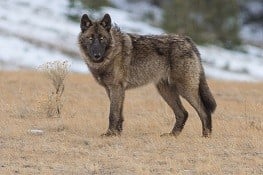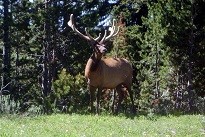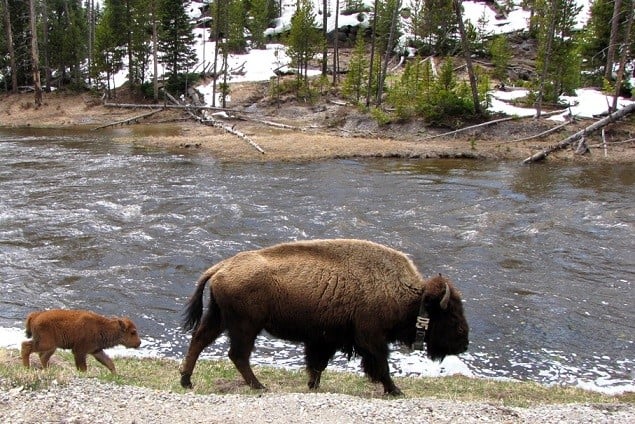
Spring is Around the Corner in Cody Yellowstone Country, and so are the Cubs, Calves and Pups
CODY, Wyo., March 1, 2018 – Spring is a time of rebirth, and many wildlife species in Cody/Yellowstone Country embrace that idea literally.
Although the first day of spring is March 21, for most residents of northwestern Wyoming’s Cody – situated east of Yellowstone National Park – the season truly begins when the babies make their debut. For some species, that is still a couple of months away.
“Around here, the spring starts when the first bear cub is spotted,” said Claudia Wade, executive director of the Park County Travel Council, the marketing arm of the region. “We typically start to see mature bears sometime in March and mothers with their cubs in April and May. By the time our summer-season visitors begin to arrive, those cubs will have begun to learn the ropes of living in the Yellowstone wilderness.”
The first cub-spotting is a big deal in Cody Yellowstone, and the word spreads fast when someone sees a young bear ambling along the road or running through a valley with its mother, said Wade.
Yellowstone Country wildlife

Wolves were reintroduced to the region more than 20 years ago.
Bison calves are often the first of the young ones to make their debut. Reddish-colored, fuzzy-furred bison calves are quick studies, and they can keep up with their mothers as soon as two hours after birth. It takes a village to protect a bison calf, and all adult bison surround young calves when predators such as wolves and bears are near.
Black bear cubs are born during the winter, and they spend the first couple of months of their lives nursing and dozing while their semiconscious mamas continue to slumber in their dens until they emerge in the spring. Mothers spend the next 16 to 18 months teaching their babies how to survive in the wild.
Moose cows aren’t quite as patient with their young. Once they give birth to a new calf – typically in May or June – they chase away the previous season’s calves. While not known for their intelligence, moose are predictably unpredictable, particularly when protecting a calf. Moose cows will chase human observers and other wildlife if they perceive a threat. Moose are frequently spotted near the northeast and east entrances to Yellowstone.
Bighorn sheep produce one or two lambs annually. Born in May or June, the lambs immediately begin the multi-year process of growing their horns. For this species, size matters. The horns on male Rocky Mountain bighorn sheep can weigh as much as 40 pounds, and the size of horns can influence a ram’s rank in the herd.

Elk are found throughout Cody/Yellowstone Country.
Elk thrive throughout Yellowstone Country, particularly in East Yellowstone Valley along the north fork of the Shoshone River. Usually born in late May and June, elk calves like most ungulates can walk within an hour or two of birth. An elk cow’s protective strategy when predators are near is to run away in hopes the predator will follow her and not notice the newborn lying motionless in the grass.
Wolf pups begin appearing in April and May, and their packs will remain with them for three to 10 weeks as they learn bit by bit how to be a wolf in Yellowstone. Their playful antics with their littermates make wolf-watching in spring especially fun. While wolves roam throughout the greater Yellowstone region, the best sightings are often in the Lamar Valley inside the park.
River otters are also born with an entertainer’s spirit, but they are a little harder to spot. Born in March and April, these aquatic nomads stay with their moms for a year as they learn how to find fish and other food and swim underwater for minutes at a time.
Eagles emerge in mid-April and fly from their nests three to four months after that. This remarkable once-endangered bird is one of 19 raptor species in the park. Northwestern Wyoming is home to bald eagles and golden eagles. Bald eagles feed on fish, and their nests can often be found in trees close to water. Golden eagles are more frequently spotted in valleys where they can accommodate their preference for rabbits and other small mammals.
Tours and tips
The best place to start when embarking on a Yellowstone Country wildlife excursion is the Draper Natural History Museum at the Buffalo Bill Center of the West in downtown Cody. The museum offers award-winning exhibits that showcase the Greater Yellowstone ecosystem and provides travelers with knowledge about what to look for and where to look.
Cody is home to several tour companies that offer wildlife tours in Yellowstone National Park and throughout the region. Visitors who prefer to self-guide are guaranteed a scenic ride along one of the five wildlife loop tours from Cody.
Travelers will find an array of overnight accommodations, from boutique inns to guest ranches, that provide a comfortable home away from home.
Above all, observe safely
Wade advises visitors to keep binoculars handy and to strictly observe recommendations to stay at least 100 yards away from bears and wolves and 25 yards away from all other wildlife. “While most visitors by far observe wildlife in a safe and respectful way, we do have incidents of visitors and animals injured because travelers got too close,” said Wade. “So, it bears repeating. This is not a zoo. It is one of the wildest places in the country.”
###
Cody/Yellowstone Country is comprised of the towns of Cody, Powell and Meeteetse as well as the valley east of Yellowstone National Park.
The area of Park County called “Cody/Yellowstone Country” was the playground of Buffalo Bill Cody himself. Buffalo Bill founded the town of Cody in 1896, and the entire region was driven and is still heavily influenced by the vision of the Colonel. Today its broad streets, world-class museum Buffalo Bill Center of the West and thriving western culture host nearly 1 million visitors annually.
Related hashtags: #YellowstoneCountry #CodyWyoming #CenteroftheWest #BuffaloBill #Yellowstone #Wyoming
Media contact:
Mesereau Travel Public Relations
(970) 286-2751


